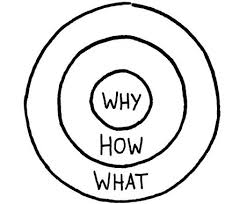
Quick Takes:
I love business, and so should you. Business is so cool. Any time you have an organization that is as qualitative as it is quantitative, as physical as it is psychological, you’re in for a real treat - or at least a wild ride.
We’ve talked in the past about Simon Sinek’s Start With Why TED Talk, and qualitatively, that should be the starting point of every business. Why does your business exist? And let me give you a hint, it’s not to make profits, even if that’s your true aim. Try telling your consumer or supplier the only reason you’re around is to squeeze them for money.
 The existence of your business needs to have a higher purpose than sales, profits, or a lucrative exit. It needs a calling that adds consistent and lasting value to its stakeholders. A calling so high that the only possible option is to answer it. Successful companies understand this by implementing a bottom up strategy of why (purpose), how (unique differentiator), and what (product/service), rather than the prevailing strategy of what (sales), how (operations), and why (profits).
The existence of your business needs to have a higher purpose than sales, profits, or a lucrative exit. It needs a calling that adds consistent and lasting value to its stakeholders. A calling so high that the only possible option is to answer it. Successful companies understand this by implementing a bottom up strategy of why (purpose), how (unique differentiator), and what (product/service), rather than the prevailing strategy of what (sales), how (operations), and why (profits).
Sinek sums it up beautifully by stating that “people don’t buy what you do they buy why you do it.”
For us pragmatic folk, focusing on the why makes sense intuitively, but it comes off as a little feely, seemingly based on someone’s gut. Business should be driven by analytics, not feel good TED talks. But what if I told you, as a pragmatic folk myself, that not only do quantitative metrics support this, but it’s as simple an exercise as reviewing your P&L.
Profit and Loss Statements - known as P&Ls - measure the success of your business, from sales to profit. Looking at a P&L from the top down, you will see, in this order:
- Sales
- Cost of sales (what it costs to produce your product/service in terms of materials, etc.)
- Operating costs (all expenses that go into operating a business - rent, wages, equipment, etc.)
- Taxes
- Profits
Traditional business teaches you to look from sales to profit, almost as if you’re playing Plinko with dollar bills.
Taking Sinek’s “why?” into account, however, changes traditional business thinking completely. Rather than looking at your company top-down, it’s better to back your way into the quantitative why, and make sure it aligns with the qualitative one.
Start with profit. Earnings are an event, a byproduct of everything that goes into your why. It may be the end result of your business - and the ultimate measure of it’s efficiency - but there is a lot that goes into it. Operating costs, for one, go a long way into either increasing or decreasing your profit.
Operating costs pay the overhead that allows you to achieve your why - allows you to operate your business. They pay for the internal infrastructure of your company. Reducing operating costs streamlines your business and increases your profits. When it comes to overhead, be a cost reducer.
These costs however, although they are a determinant of profit, are not the “why?”, but are yet another end result. An end result of sales and cost of sales.
Cost of sales account for all the materials that go into creating your product/service. Cost of sales determines one portion of your operating costs, while the other portion is determined by the actual product you sell. If you sell a product made out of plastic, for example, and decide you want to lease a plastics factory to mold your own product, the physical plastic materials would go into cost of sales, while the lease payment, wages of the factory workers, etc., would go into operating costs.
BUT, while sales and cost of sales drive operating costs, the sale of a product drives its own cost of sales. If you want to add a feature to your product to increase its value or effectiveness, you’ll need to naturally increase your cost of sales. To add this feature, you may also have to increase or adjust your operations. This means that sales drives the entire operations of your company, and therefore the entire operating costs. If this holds true, sales would than drive your cost of sales, operating costs, and therefore your profit.
Much like being a cost reducer when it comes to operations, with sales, you want to be a revenue producer.
 From a quantitative perspective, sales is the catalyst for everything in your business. Every single cost center of your company is spent to either create your product/service or support the sales of your product/service. Any adjustment you make to your product or sales strategy will affect every part of your business. When it comes to dollars and cents, the quantitative “why?", sales are king.
From a quantitative perspective, sales is the catalyst for everything in your business. Every single cost center of your company is spent to either create your product/service or support the sales of your product/service. Any adjustment you make to your product or sales strategy will affect every part of your business. When it comes to dollars and cents, the quantitative “why?", sales are king.
Which leads seamlessly back to why you exist. The most important qualitative components of your company are: why, how, and what. The most important quantitative components of your business are: sales, operations, and profits. There is an intersection, then, where your “what" is your product/service and your “sales” are how you sell that product/service. Your “what” essentially drives your sales.
Therefore, in order to be successful, a business needs to focus on these things, in this order: why, how, what, sales, operations, and profits.
It doesn’t matter if you take a qualitative, "go with your gut", type of business philosophy or a quantitative, "let the numbers decide", type of business approach. Why your business exists is affects how you exist, which drives what you do to exist. What you do to exist directly relates to the sales of your company, which drives the operations of your business, and ultimately its profits.
So, whether your aim is profits, a lean operation, massive sales, or social impact and awareness, it’s always important to start with “why?”. This way, instead of playing Plinko, you play the game of immediate and lasting value, which is no game at all.